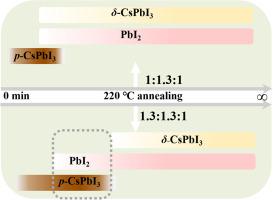Nano Energy ( IF 16.8 ) Pub Date : 2021-02-13 , DOI: 10.1016/j.nanoen.2021.105881 Hailiang Wang , Huicong Liu , Zijing Dong , Weiping Li , Liqun Zhu , Haining Chen

|
The inorganic CsPbI3 perovskite obtained from dimethylammonium iodide (DMAI)-related strategies have greatly promoted the development of CsPbI3 perovskite solar cells (PSCs). However, deeper understandings are urgently needed to further enhance device performance. Herein, the crystallization processes of DMAI-based strategy are systematically studied and some new understandings are proposed. During annealing, β-phase-like CsPbI3 is first formed and then gradually transits to γ-phase-like structure. DMA ions tend more to form DMAPbI3 in the system, implying the amount of alloyed DMA ions in CsPbI3 would be very limited. In addition, the pre-generated Cs4PbI6 plays an important role in stabilizing CsPbI3 perovskite phase at low temperature. These findings help us to finely manipulate film composition, and the quality of CsPbI3 film is substantially improved after simultaneously suppressing the formation of δ-CsPbI3, minimizing DMAPbI3 residual and generating PbI2 passivator. More promisingly, the carbon-based CsPbI3 PSCs without hole transporter achieve a record efficiency of 14.6%.
中文翻译:

成分操纵可将碳基CsPbI 3钙钛矿太阳能电池的效率提高到14%以上
从二甲基碘化铵(DMAI)相关策略获得的无机CsPbI 3钙钛矿极大地促进了CsPbI 3钙钛矿太阳能电池(PSC)的发展。但是,迫切需要更深入的了解,以进一步提高设备性能。在此,系统地研究了基于DMAI的策略的结晶过程,并提出了一些新的认识。在退火过程中,先形成β相的CsPbI 3,然后逐渐转变为γ相的结构。DMA离子趋于更形成DMAPbI 3在系统中,这意味着在CsPbI合金DMA离子的量3将是非常有限的。另外,预先生成的Cs4 PbI 6在低温下稳定CsPbI 3钙钛矿相中起着重要作用。这些发现有助于我们精细地控制膜组成,并且在同时抑制δ- CsPbI 3的形成,最小化DMAPbI 3残留并生成PbI 2钝化剂之后,CsPbI 3膜的质量得到了显着改善。更令人鼓舞的是,不带空穴传输剂的碳基CsPbI 3 PSC实现了14.6%的创纪录效率。











































 京公网安备 11010802027423号
京公网安备 11010802027423号